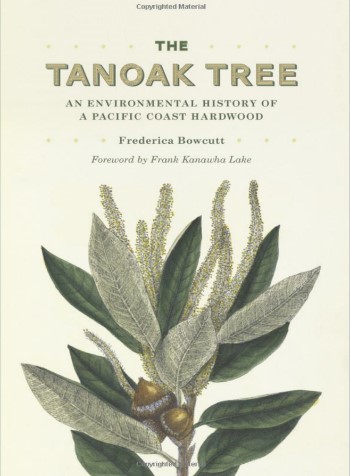The Tanoak Tree: An Environmental History of a Pacific Coast

Book Covers
Title:The Tanoak Tree: An Environmental History of a Pacific Coast Hardwood
《美洲密花石栎:太平洋海岸硬木的环境史》
Author:Frederica Bowcutt
Publisher: University of Washington Press
Publication Date: June 26, 2017
About the Author
Frederica Bowcutt teaches botany in interdisciplinary programs at The Evergreen State College. As a member of the faculty since 1996, she has specialized in floristics, field plant ecology, and plant-centric environmental history. Her first book, The Tanoak Tree: An Environmental History of a Pacific Coast Hardwood, was published in May 2015 by the University of Washington Press. It was released in paperback in 2017. Her second book, Vascular Plants of the South Sound Prairies, was published by The Evergreen State College Press in 2016. It was co-edited with Dr. Sarah Hamman, restoration ecologist from the Center for Natural Lands Management. Dr. Bowcutt has also published multiple floras on state parks in the North Coast Range and Central Valley of California. Her essays have appeared in a variety of journals including Aliso, California Fish and Game, Environmental History, Human Ecology, and Madroño as well as an anthology compiled by Carolyn Merchant entitled Green Versus Gold: Sources in California’s Environmental History.
She holds a bachelors from the University of California, Berkeley and a masters from the University of California at Davis (UCD), both in botany. Before earning her Ph.D. in ecology from UCD, she worked for five years as an ecologist for the California Department of Parks and Recreation. She has also worked as an environmental consultant doing rare plant surveys and ecological restoration.
Book Contents
Tanoak (Notholithocarpus densiflorus) is a resilient and common hardwood tree native to California and southwestern Oregon. People's radically different perceptions of it have ranged from treasured food plant to cash crop to trash tree. Having studied the patterns of tanoak use and abuse for nearly twenty years, botanist Frederica Bowcutt uncovers a complex history of cultural, sociopolitical, and economic factors affecting the tree's fate.
Still valued by indigenous communities for its nutritious acorn nut, the tree has also been a source of raw resources for a variety of industries since white settlement of western North America. Despite ongoing protests, tanoaks are now commonly killed with herbicides in industrial forests in favor of more commercially valuable coast redwood and Douglas-fir. As one nontoxic alternative, many foresters and communities promote locally controlled, third-party certified sustainable hardwood production using tanoak, which doesn't depend on clearcutting and herbicide use.
Today tanoaks are experiencing massive die-offs due to sudden oak death, an introduced disease. Bowcutt examines the complex set of factors that set the stage for the tree's current ecological crisis. The end of the book focuses on hopeful changes including reintroduction of low-intensity burning to reduce conifer competition for tanoaks, emerging disease resistance in some trees, and new partnerships among tanoak defenders, including botanists, foresters, Native Americans, and plant pathologists.
Table of contents
Foreword by Frank Kanawha Lake
Acknowledgments
INTRODUCTION
1. THE BEAUTIFUL TREE
2. ACORNS
3. BARK
4. WEED
5. HARDWOOD
6. PLAGUE
7. LANDSCAPES
8. PARTNERSHIPS
CONCLUSIONS
Notes
Glossary
Bibliography
Index
REVIEW
"Bowcutt examines the history of the tanoak tree, bringing to life a rich story about how humans are connected to this beautiful yet unassuming tree [T]his valuable book will be important for a broad audience."
―Choice
"Bowcutt's account of the invaluable but imperiled tanoak is comprehensive and well organized. . . . She provides a wealth of detail, citing hundreds of sourcces that enable engaged readers to further explore the tree's remarkable story. . . . Anyone who reads Bowcutt's deeply affecting book will be prompted to add a new call to action: 'Save the Tanoaks.'"
―Jerry Rohde, Humboldt Historian
"We may hope that one day a future edition of this nicely written, heavily referenced little book will conclude with a tale of successful restoration."
―Wendy L. Applequist, Economic Botany
"The book is an honorable treatment of Indigenous Peoples and accurately portrays their health struggles due to the loss of their ancestral diet, as well as their resilience in recreating their food systems. People with an interest in Native culture and lifeways, history, biodiversity, the environment or just fascinating reading will enjoy this book."
―Terri Hansen, Indian Country Today
"Especially good. . . . Through the lens of the tanoak Bowcutt vividly brings home how carelessly and how rapidly our own species has exploited and manipulated nature, and how devastating our impacts have been. . . . [The tanoak], as is so thoroughly documented in the book, should stimulate reflection on the ethics of how we use our power to change the natural world."
―Peter Crane, H-Environment
"A fascinating treatment of a tree that remains central to the region's Native American cultures but has little value to the timber industry. . . . This is a model of how histories can deploy visuals as central storytelling tools. . . . This is a fine addition to the literatures of historical ecology and forest history."
―Erik Loomis, Environmental History
"This book will be helpful for someone wanting a general overview of tanoak-conifer forest of southwestern Oregon and northern California. It could serve as a basis for, or as part of, a seminar or class on broadening the scope of forest management to include Native American cultural values in contemporary western U.S. forests."
―John Tappeiner, Northwest Science